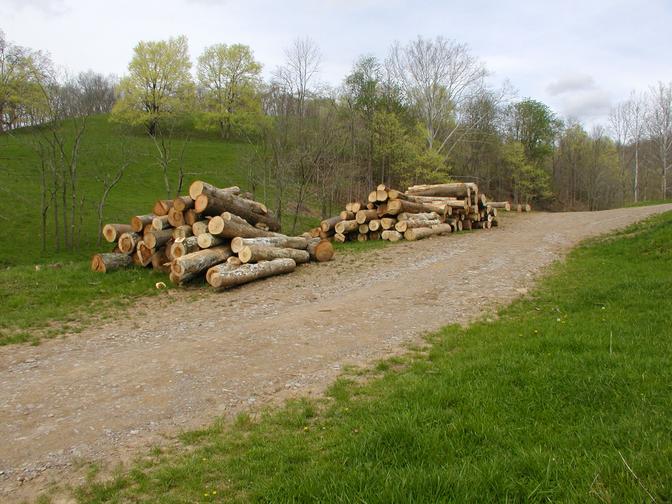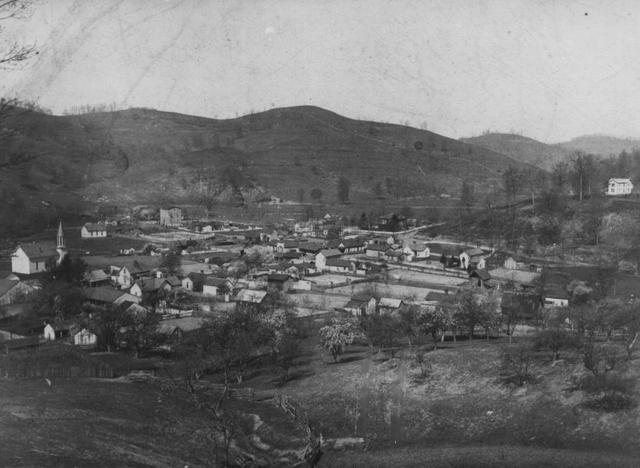
| Next Chapter | Previous Chapter | |
| Chapter 40: Water Quality | Contents | Chapter 38: The Education of a Farmer, Values and Practical Learning |
The great Appalachian forest was gone long before my father or grandfathers could see it. Just about every square foot was cut over – some for timber, some just cleared for pasture and crop land. The earliest photographs of the landscape show only the steepest and highest hilltops covered with trees in this area. The maximum pressure against the forest must have come about the time of the first world war or a little after. Population density was high, people did a lot of hand work, and transportation of food and other things was poor. When tractors came in after WWII, much of the farmland was abandoned, because a substantial part of it could be farmed only with horses or by hand. Doddridge County lost fifty percent of its population in one decade from 1950 to 1960, houses, churches, everything, were abandoned in the rural areas where it was steep. When I went to college at Salem in the 1960s the pre-ministerial students went around the rural areas finding the abandoned churches and speculating about their lost congregations.
After WWII, transportation was much improved, and the West had been opened and developed with its vast agricultural potential which resulted in oversupply for decades. This led to the decrease in acreage farmed in Appalachia, and the final abandonment of much of the farmland in New England. A brother of one of the men who hunted on our farm had lived and hunted in New Hampshire, and he told me about finding stone fences in huge tracts of large timber there, land which once was farmed, many years ago.
Now, sixty years after the start of WWII, much of this abandoned West Virginia land has grown up enough to be harvested for timber. Timber is big business, witness the six million dollar a year log yard mentioned above. When I was a boy you had to go over to the mountains to find a timber business, but now it is in the West Fork River valley, too. Then we rarely smelled burning fire wood, because gas was so easy to get and very cheap. One of the attractions of visiting the mountains was the smell of wood fires.
Now every day on I-79 you see log trucks, some hauling north, some hauling south. I have heard people worry that Appalachia will be over cut, but now more than 90 percent of the acreage of West Virginia is growing timber.
(Illustration 39-1)

Timber is a product of most Appalachian farms, too. The logs are Sycamore for mine ties.
The cultivation of timber in Appalachia leaves much to be desired, though. It is still almost entirely the harvest of what happens to come up. And there is still tremendous waste in the forest, although once it gets to the mill there is little waste, even sawdust is being used in some cases. In contrast we see the cultivated forests of Europe in pictures: trimmed, fertilized, uniform in species and spacing. When will the demand for hardwood bring something like that to this area?
Some areas are being cleared again, mostly by hand labor, although no significant amount. I recognized this about 20 years ago driving the back roads to Salem. It is population pressure that is doing it. Young men move out to the edges of the cultivated area and trade labor for land to farm on, just the way the forest was cleared originally. Who knows what the future will bring? Is the food produced by annual harvest of calves worth more or is the once in eighty years harvest of trees worth more? Certainly there will be a mix, but what will be that mix, more forest or more open land?
On this farm we now market most of our timber with the help of a forester, David Hill. The forester goes into a tract of trees and selects the ones which should be cut, measures them and estimates the board feet of each tree, records each tree and marks them, and collates the results for each species. He knows the board feet of each species, puts the tract up for bids and writes a contract. He also watches the crew that cuts the trees, and sees that they follow the contract, and do not break any regulations. His reputation for honesty and fairness is very important both to the landowner and to the timber company to which he sells the timber.
Some anecdotes about timber follow. The first timbering I can remember was the back corner of the Lost Creek farm. It was next to the Maxwell and Stout farms, now Lowther and Stenger. It had to be cut before the coal was stripped the first time. This was done by two men named Freemen, a father and a son, and my Dad. The young man was about Dad’s age, 40s, and his father was about twenty years older.
They made a road around the hill from the coal road to where the mill was set up, brought in the mill, and did most of the tree cutting. This was before chain saws. I remember they were always filing their two man cross cut saws, it was very important to keep them sharp. When they sawed with them they oiled the saw with kerosene, to make it pull easily. They cut a tree by “under cutting” for a notch with the saw on one side, in the direction they wanted the tree to fall, then they chopped out the notch. Next they would saw from the opposite side, leaving a “hinge” between the notch and the final cut which would direct the fall of the tree. They drove a hook into the logs and used a chain and horses to pull them in to the mill. They were rolled onto the mill platform with “cant hooks,” which are like peaveys, except that there is a little hook on the business end of the handle, an inch out from the side, rather than the spike found on the end of a peavey.
There was some lumber produced, part of which the Freemens sold, and some mine props (used to prop up the ceiling in coal mines) and quite a few railroad ties, including some double length, used to set off sidings. It was hauled on Dad’s truck, mostly. One day Dad and the younger Freeman picked up a double length railroad tie (eight inches wide, six inches thick, sixteen feet long red oak) to carry it to the truck. When they had reached the truck they looked back, and the old man Freeman was coming behind with one all by himself!
This next story was told by a fellow who was a custodian at Byrd High School when I taught there. Alvin “Slim” Morrison worked in the timber further south and east in the state before World War II, when he had been a soldier. He was the archetypical mountaineer, tall, thin, quiet, but good with a story. He loved horses, and those early days it was his job to move timber from where it was cut in to the mill. Many places the mountain tracks were so steep that the log would catch up with the horses, with the consequence that they could get a leg broken. Slim had to pull the horses aside, and the log would go shooting on by, pulling out the hook in the log. Then he could reconnect when the log stopped and pull it on into the mill. If a horse’s leg was broken, the horse was useless and had to be killed. I think a lot of skill and training of the horses went into the maneuver, but from the way he talked, it was routine in the steep mountains.
(Illustration 39-2)

Lost Creek, about 1910. Notice the absence of trees on the hills, which have been cleared away for pasture for the cattle industry. There is an orchard on the hillside close to the bottom right of the picture. Deer had been driven to extinction in this area 20 to 30 years before by hunting with dogs.
To remove the trees from our most recent timber sale (2001) there was a bulldozer, a Caterpillar model D5H, a John Deere skidder model, 640-E, which was able to pull logs at 20 miles an hour, a Hood stacker with bucksaw, to trim and sort the logs and load them on trucks. It is constructed with a long arm with a grapple on the end, and the operator, Bob Thomas, handles it like it was part of his own body. Logs are cut to length and sorted, some for chipping to make particleboard, and the better ones for saw logs. The logs were hauled away in eighteen wheel trailer trucks, which were actually kept clean! Two to five truckloads a day were sent. Each one of these pieces of equipment cost more than we received for the timber, most of them several times what we received! The company was Paul Thomas from Cumberland, Maryland.
They don’t drive a hook into the log now, because it ruins part of the log. They put a chain around it or a cable which slips up tight, like a noose. Our neighbors, Charles and Drema Shaver, got a dump truck to haul fire wood leftovers from the trimming to sell at their greenhouse, The Garden Spot.
In the past black walnut was the highest priced wood. It is dark, dense and fine grain, so it polishes well. Today the Japanese market demands a light wood. Cherry and white oak bring the best prices. Ash is good for handles, red oak for construction. Really fine trees are hard to find, something that is sixteen inches d. b. h. (diameter at breast height) up. Some very poor timber is cut for pulp wood (to make paper) and for chipping (to make particle board). The best, largest logs are used to make veneer, some to be applied to dimensional wood used in furniture, but most now for paneling.
Aside One change that is about to come about on our farm is the use of radio for communication while driving cattle. 2002 is the first time we have had Citizen’s Band radios. These are palm-sized radios that allow communication for a mile or more. They are very useful for moving cattle through wooded areas and in large fields .
| Next Chapter | Previous Chapter | |
| Chapter 40: Water Quality | Contents | Chapter 38: The Education of a Farmer, Values and Practical Learning |
Copyright © 1998, 2006, 2008, 2011 S. Tom Bond (stombond at hughes.net)